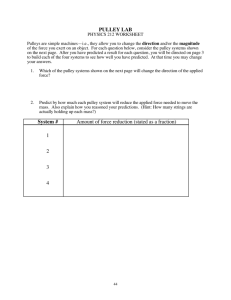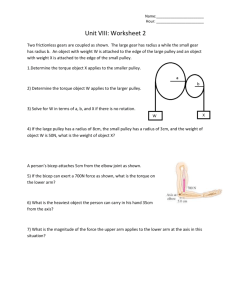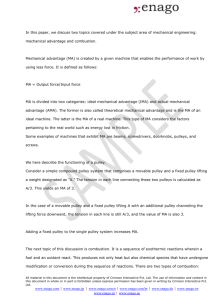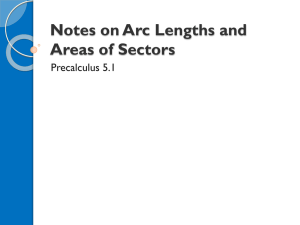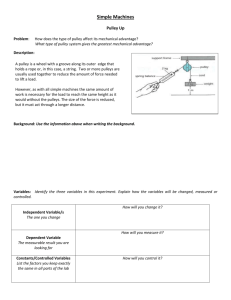Pulleys
advertisement
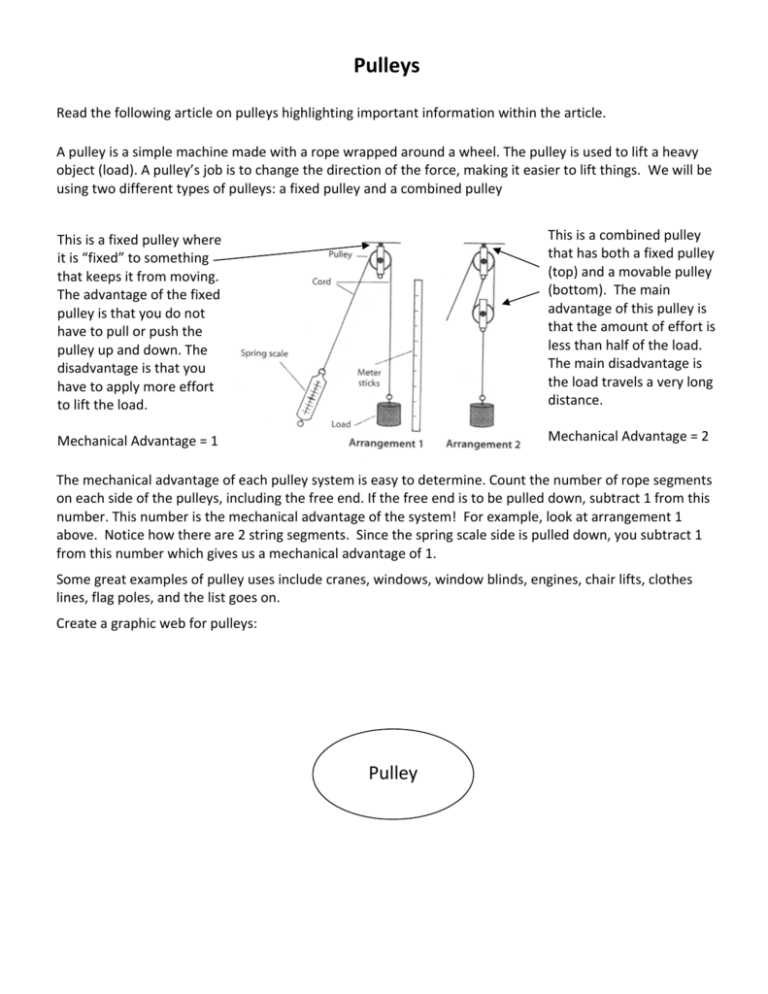
Pulleys Read the following article on pulleys highlighting important information within the article. A pulley is a simple machine made with a rope wrapped around a wheel. The pulley is used to lift a heavy object (load). A pulley’s job is to change the direction of the force, making it easier to lift things. We will be using two different types of pulleys: a fixed pulley and a combined pulley This is a combined pulley This is a fixed pulley where that has both a fixed pulley it is “fixed” to something (top) and a movable pulley that keeps it from moving. (bottom). The main The advantage of the fixed advantage of this pulley is pulley is that you do not that the amount of effort is have to pull or push the less than half of the load. pulley up and down. The The main disadvantage is disadvantage is that you the load travels a very long have to apply more effort distance. to lift the load. Mechanical Advantage = 2 Mechanical Advantage = 1 The mechanical advantage of each pulley system is easy to determine. Count the number of rope segments on each side of the pulleys, including the free end. If the free end is to be pulled down, subtract 1 from this number. This number is the mechanical advantage of the system! For example, look at arrangement 1 above. Notice how there are 2 string segments. Since the spring scale side is pulled down, you subtract 1 from this number which gives us a mechanical advantage of 1. Some great examples of pulley uses include cranes, windows, window blinds, engines, chair lifts, clothes lines, flag poles, and the list goes on. Create a graphic web for pulleys: Pulley How does a pulley work as a simple machine? 1. There is a 1 kilogram weight (1000 grams) attached to the right side of the single pulley string just like the picture below in arrangement 1. 2. Count the number of rope segments on each side of the pulley, including the free end. If the free end is to be pulled down, subtract 1 from this number. This number is the mechanical advantage. Record the MA in the chart below. 3. Based on your MA, predict the weight on the spring scale __________________________ 4. Note: One person must hold the base of the pulley at all times. 5. Pull on the spring scale to lift the 1000 gram weight. Stop when the 1000 gram weight moves approximately 10 centimeters off the counter. Record the weight measured by the spring scale. Mechanical Advantage 1 pulley Original weight of the load Weight on the spring scale when pulled 10 cm off table 1000 grams 6. Compare your predicted weight to the actual weight. Is there a difference? ___________________________________________________________________________ ___________________________________________________________________________ 7. Repeat the previous steps for the two pulley set‐up. First, count the number of rope segments on each side of the pulley, including the free end. If the free end is to be pulled down, subtract 1 from this number. This number is the mechanical advantage. Record the MA in the chart below. 8. Based on your MA, predict the weight on the spring scale __________________________ 9. Reminder, one person must hold the base of the pulley at all times. 10. Pull on the spring scale to lift the 1000 gram weight. Stop when the 1000 gram weight moves approximately 10 centimeters off the counter. Record the weight measured by the spring scale. Mechanical Advantage 2 pulleys Original weight of the load Weight on the spring scale when pulled 10 cm off table 1000 grams 11. Compare your predicted weight to the actual weight. Is there a difference? ___________________________________________________________________________ ___________________________________________________________________________ 12. Does doubling the number of pulleys change the mechanical advantage? By how much? _________________________________________________________________________________ _________________________________________________________________________________ 13. How does doubling the number of pulleys change how much weight is needed to lift the load? _________________________________________________________________________________ _________________________________________________________________________________ 14. Repeat the previous steps for the two pulley set‐up. First, count the number of rope segments on each side of the pulley, including the free end. If the free end is to be pulled down, subtract 1 from this number. This number is the mechanical advantage. Record the MA in the chart below. 15. Based on your MA, predict the weight on the spring scale __________________________ 16. Reminder, one person must hold the base of the pulley at all times. 17. Pull on the spring scale to lift the 1000 gram weight. Stop when the 1000 gram weight moves approximately 10 centimeters off the counter. Record the weight measured by the spring scale. Mechanical Advantage 4 Pulleys Original weight of the load Weight on the spring scale when pulled 10 cm off table 1000 grams 18. Using all three experiments, compare the number of pulleys to the actual mechanical advantage. What pattern do you notice when the rope is pulled down? _______________________________________________________________________________ _______________________________________________________________________________ 19. Which pulley system requires you to pull the string a longer distance to reach 10 centimeters? _______________________________________________________________________________ _______________________________________________________________________________ 20. Based on your lab work, determine the mechanical advantage for each pulley system. Assume that the spring scale is being pulled down similar to each of your labs. Then, calculate the weight needed to lift each load in the pulley systems. 1 Pulley 2 Pulleys 4 Pulleys 6 Pulleys 8 Pulleys Actual Weight of the load 1000 grams 1000 grams 1000 grams 1000 grams 1000 grams Mechanical Advantage Weight of the load using a pulley
